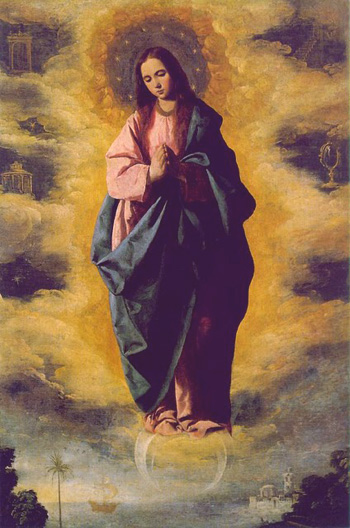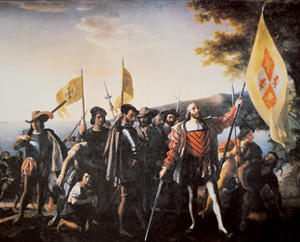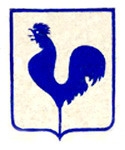 |
Stories & Legends
The Immaculate Conception in the
Age of Discovery
Elaine Jordan
Love and devotion to the Mother of God is deeply rooted in the Catholic faithful. The Church honors her with solemnity on her feast days – the Annunciation, Visitation, Assumption, and the Immaculate Conception. The doctrine of the Immaculate Conception teaching us that she had been preserved from any stain of sin since her conception became a dogma under Pope Pius IX with the Apostolic Letter Ineffabilis Deus of December 8, 1854.
But for many centuries before that date, the Immaculate Conception of Our Lady – a topic of discussion among theologians – was commemorated with great devotion by the faithful. Of all the countries of Christendom, Spain proudly assumed a first position in defending this doctrine, especially in the period of the Catholic Kings Ferdinand and Isabella and the Age of Discovery.
Devotion of the Catholic Monarchs

Zurbanan's famous painting is a homage of the Spanish people to the Immaculate Conception |
King Ferdinand and Queen Isabella were great devotees of the Imaculada. Isabella ‘la Catolica’ founded three Immaculate Conception chapels in her will: one in Guadalupe, another in Toledo, and another in Seville. She also provided the funds so that the day of the Immaculate Conception could be solemnly celebrated each year in those chapels.
Another similar foundation was made by the Catholic King and Queen in Seville in thanksgiving for a victory against Portugal.
In the archives of the Cathedral of Toledo is an official record reporting: “The most serene Queen Isabella and King Ferdinand, with the zeal and devotion that they have for this holy Church, hereby order that on the day of the Immaculate Conception of Our Lady, this feast should be celebrated in it in their names and those of the Prince Don Juan and their other sons and daughters now and for all times.”
Although nothing is said here about the reason for this bequest, it is affirmed elsewhere that it was to give thanks to the Virgin for having saved the life of King Ferdinand after he suffered a stab wound received from a madman in Barcelona. The King was at the point of death, but recovered on the Vespers of the Immaculate Conception. The King also attributed this recovery to the Virgin of Pilar, and for this reason he ordered a necklace of precious jewels to be made to adorn the dress of the Sacred Statue.
King Ferdinand also solicited indulgences from Rome for the Confraternity of the Conception, as well as for those who heard Mass on the day of the Immaculate Conception.
The Discovery of America
It was a pious custom for the Spanish explorers and conquistadores of the New World to acknowledge the Virgin as “capitana” [the captain]. Christopher Columbus with all his men asked the blessing of Holy Virgin and received Holy Communion before departing.
The official name on the flagship for the first expedition was La Gallega (The Galician) because she was built in Pontrevedra, Galicia, but it was commonly called Marigalante, or Gallant Mary. In order to have a name worthy for the grand enterprise being undertaken, Columbus ordered it henceforth be called Santa María de la Imaculada Concepción (Holy Mary of the Immaculate Conception). This was the largest of the three ships that set sail for America, and the one on which Columbus sailed.

Columbus named the second island he found in the New World Santa Maria de la Concepcion |
The Columbus expedition left Palos on the vespers of the Virgen de las Nieves and the first land in America was sighted on October 11, 1492, the vespers of the Virgin de Pilar. This is how Columbus recorded the discoveries in his diary. Immediately after land was sighted, Columbus ordered the entire crew to pray the Salve Regina. The next morning they discovered the first island [in the Bahamas], which was consecrated to Jesus Christ. It was called San Salvador.
On the next day they found another island, which Columbus dedicated to Our Lady, writing in his diary, "To this island I gave the name Sancta Maria de la Concepcion."
The Catholic King sent to the Virgen de las Nieves a part of the first gold that Columbus brought from America, and Isabella ordered that a statue of the Blessed Virgin should be made and sent to the island of Santo Domingo so that she might be its Patroness.
In his Last Testament made in 1498, Columbus commanded his son Don Diego “to build a church under the title Santa Maria de la Conception on the Spanish island of Santo Domingo. He also ordered Diego to keep a chapel in which three chaplains would say three Masses a day - one in honor of the Holy Trinity, one in honor of the Conception of Our Lady, and one for the souls of Columbus and his wife.
His remains were transferred to a crypt beneath a statue of the Virgin in Santo Domingo (Dominican Republic) in 1542 after being sent there from the Cathedral of Seville. Spain disputes this claim, which has not been resolved unanimously by historians to this day.

Translated and adapted from Antonio Jiménez Sánchez,
Beatriz da Silva y la Immaculada Concepción. Origenes de una Orden, Diocesan seminary, Malaga
Posted May 22, 2010


Related Topics of Interest
 Isabella of Castile’s Childhood Isabella of Castile’s Childhood
 The Catholic Church in Colonial America The Catholic Church in Colonial America
 La Conquistadora, Our Country's Oldest Madonna La Conquistadora, Our Country's Oldest Madonna
 Hernan Perez del Pulgar,‘The One of the Valiant Deeds’ Hernan Perez del Pulgar,‘The One of the Valiant Deeds’
 Pelayo and Our Lady of Covadonga Pelayo and Our Lady of Covadonga
 The Miracle of Ourique and the Birth of Portugal The Miracle of Ourique and the Birth of Portugal

Related Works of Interest
| |
|
Legends | Religious |
Home | Books | CDs | Search | Contact Us | Donate

© 2002-
Tradition in Action, Inc. All Rights Reserved
|
 |
|